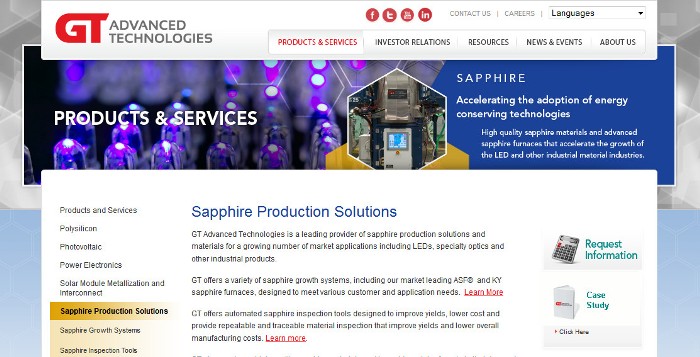Sapphire Glass vs Corning’s Gorilla Glass: What’s the Real Score?

Screenshot of Corning’s Gorilla Glass vs Sapphire Glass Video Presentation (http://www.corninggorillaglass.com/gorilla-channel/Corning%C2%AE-Gorilla%C2%AE-Glass-vs.-Sapphire)
When information about Apple’s plan to shift to the use of sapphire glass emerged , Corning, the producer of the popular Gorilla Glass, immediately released informational materials that aimed to highlight the advantages of Gorilla Glass over sapphire glass. Now, comparisons resurface as the iPhone seems to be almost certain to sport a sapphire glass protected display.
Recently, there have been a few videos that emerged online exploring the perceived advantages and durability of sapphire glass. On YouTube, for instance, Kyocera volunteered to have their Brigadier sapphire shield glass tortured for a scratch test. So what really is the real score in the battle between sapphire glass and Corning’s Gorilla Glass? Know more in the following discussions:
Is Sapphire Glass Really Better?
Unfortunately, the answer here isn’t going to be a simple yes or no. there are many aspects to be considered. Hence, the answers would be different for different considerations.
No, Because It’s More Expensive
While Corning is not keen on showing the secrets to producing the durable Gorilla Glass, saying that sapphire glass is more expensive to produce is a no-brainer. Obviously, Apple has no intentions of producing sapphire glass to be used on their displays by mining the raw materials. They will be synthesizing it. It’s less expensive than obtaining natural sapphires but still significantly more expensive than producing tempered glass panels such as Gorilla and Dragontrail glass.
For the uninitiated, sapphire is a naturally occurring gemstone that exists in a variety of forms and colors. Sapphire is a collective term for a number of gemstones including ruby (red or pink). Other colors include orange, purple, yellow, and greenish blue depending on the impurities found in the sapphire. Ruby has chromium impurities.
Aside from the fact that sapphire is considered a gemstone, the manufacturing process involved is also a major contributor to the cost. Synthetic sapphire involves a lengthy process of seeding, charging, melting, growing, and the production of boules. Furnaces need to be heated up to 1815°C to be able to melt an amount of sapphire that is about the size of a hockey puck. Moreover, sapphire is significantly harder than Gorilla Glass so cutting it according the sizes needed for a specific device will also entail a costly process.
According to industry estimates, producing a sapphire glass panel for an iPhone would cost around $10. This is after production improvements have been implemented. Sans these improvements, the cost would have stayed at the $25 levels. The $10 cost is still thrice more than the cost of producing a similarly sized Gorilla Glass, though.
![By Kelvinsong (Own work) [CC-BY-3.0 (http://creativecommons.org/licenses/by/3.0)], via Wikimedia Commons](https://techtheday.com/wp-content/uploads/2014/03/iphone-sapphire-display.png)
By Kelvinsong (Own work) [CC-BY-3.0 (http://creativecommons.org/licenses/by/3.0)], via Wikimedia Commons
Yes, Because It’s More Durable
Despite all the costs and lengthy process, sapphire comes out as the superior material in terms of durability. As we have mentioned in an earlier post about sapphire glass, its hardness ratings comes close to the hardest mineral known to mankind. On the Mohs scale, it is assigned a 9, just one point short of rating given to diamonds. Compared to glass, which has 5, it is definitely much harder.
Sapphire glass producer GT Advanced conducted a test to compare the hardness of sapphire glass against the top tempered glass available in the market at present. One of the tests they conducted made use of the Knoop hardness test standard. Knoop hardness test is a microhardness test used to assess the mechanical hardness of brittle materials or thin sheets. This test can be considered better than the Mohs scale rating comparison since it’s really intended for thin brittle materials like the glass used in covering the displays of modern devices. According to GT Advanced, sapphire has a Knoop hardness of 18.6, giving it a clear advantage over Gorilla Glass’ 6.17, Dragontrail’s 6.95, Xensation’s 6.26, and soda lime glass’ 6.03.
Other durability testing methods used by GT Advanced include Young’s Elastic Modulus, Mean Fixture Strength, Shear Modulus, Fracture Toughness, Vickers Hardness, Dielectric Constant, and refractive index. For these tests, sapphire scored 345 GPa, 895 MPa, 145 GPa, 2.3 MPa√m, 2,200 kg/mm², 9.39 k, and 1.76 n respectively. Obviously, sapphire glass trumps all types of durable and “scratch-resistant” glass available in the market today. It even has a significantly higher density compared other commercial glasses for device displays at of 3.97 g/cm³ (against the 2.42 and 2.48 of Gorilla Glass and Dragontrail respectively).
Ultimately, it can be said that the use of sapphire glass is not really bound to deliver any significant advantage to consumers. Some would say that there are reasons why Corning, the current king of device display glass protection, should be nervous about the coming of sapphire glass but in all practicality, there really isn’t anything. For once, the use of sapphire glass does not drop-proof a smartphone. Sapphire will still break, only not as likely as other glass would. Those who want to design an elegant looking smartphone with a glass-dominated body can look at Sony’s Xperia Z line. Sony’s design makes use of a frame with very slightly protruding corners that prevent the glass from directly hitting something hard when dropped. That’s why Sony was confident in dropping their Xperia Z1 model at their MWC booth.
Yes, sapphire glass comes with its many bells and whistles but it is not really bound to offer considerable practical advantages. It can do so much to raise the prestige of a device (i.e. the “sapphire-protected” marketing line) but it will not create any material improvement to the user experience. It’s just like having a device encrusted with swarovski crystals. We have nothing against the use of new technologies but if these don’t really bring practical benefits, it’s better sticking with the less expensive option.
